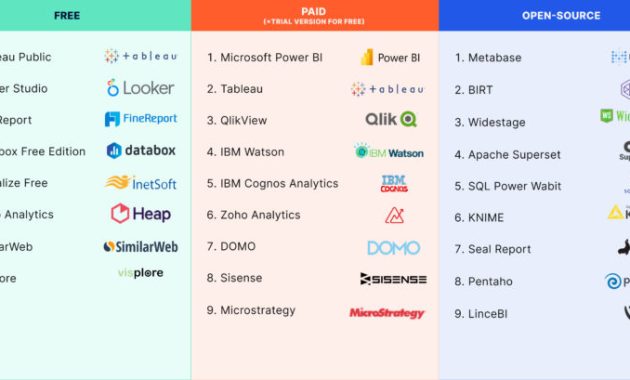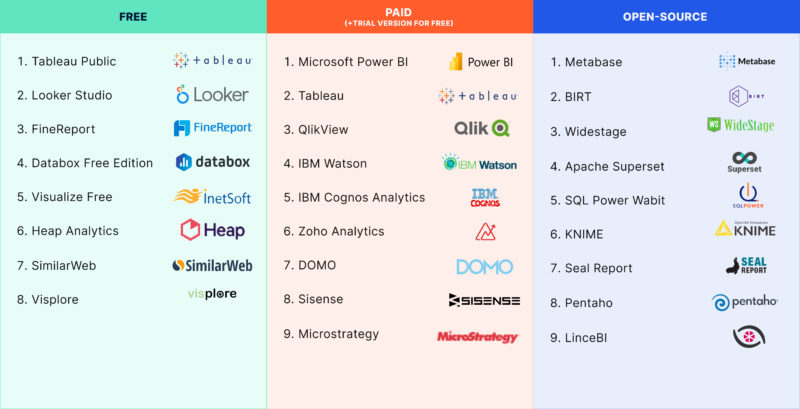
Business Intelligence Tools to Align Data with KPIs: A Strategic Guide
In today’s data-driven landscape, businesses are drowning in information. However, raw data is useless without the right tools and strategies to transform it into actionable insights. This is where Business Intelligence (BI) tools come into play. They are essential for aligning data with Key Performance Indicators (KPIs). This alignment is crucial for strategic decision-making, performance monitoring, and achieving business objectives. This guide explores the vital role of BI tools, how they integrate with KPIs, and the benefits they provide.
The core function of Business Intelligence tools is to gather, analyze, and present data in a way that is easily understandable. This allows organizations to identify trends, patterns, and anomalies. By connecting these insights to KPIs, businesses gain a clear understanding of their performance. They can track progress toward their goals and make informed decisions. This strategic alignment is the key to sustainable growth and competitive advantage.
Understanding Key Performance Indicators (KPIs)
KPIs are quantifiable metrics that measure the success of an organization. They provide a clear picture of how well a company is achieving its objectives. KPIs are tailored to specific business goals, such as increasing revenue, improving customer satisfaction, or reducing operational costs. Well-defined KPIs are vital for effective performance management and strategic planning.
KPIs are usually categorized based on the type of business and the specific goals. Sales teams, for example, might focus on KPIs like sales revenue, customer acquisition cost, and conversion rates. Marketing teams may track website traffic, lead generation, and social media engagement. Operations teams would monitor KPIs like production efficiency, inventory turnover, and on-time delivery. Finance teams would focus on profitability, return on investment, and cash flow.
Selecting the right KPIs is crucial. They should be Specific, Measurable, Achievable, Relevant, and Time-bound (SMART). SMART KPIs ensure that the objectives are clear and that progress can be effectively tracked. This approach makes it easier to assess performance and make necessary adjustments.
The Role of Business Intelligence Tools
Business Intelligence tools act as the bridge between raw data and actionable insights. They facilitate the collection, integration, and analysis of data from various sources. This includes databases, spreadsheets, cloud services, and other business systems. These tools transform this raw data into meaningful information that supports strategic decision-making.
Business Intelligence tools offer a range of functionalities. These include data visualization, reporting, dashboards, and advanced analytics. Data visualization tools create charts, graphs, and other visual representations of data. This simplifies complex information and makes it easier to understand trends and patterns. Reporting features allow users to generate custom reports. Dashboards provide a real-time overview of key metrics and performance indicators. Advanced analytics capabilities enable predictive modeling and forecasting.
The best Business Intelligence tools provide real-time data updates. This allows businesses to respond quickly to changes in the market. They can identify opportunities and address challenges promptly. Real-time data is essential for agile decision-making. It ensures that businesses stay ahead of the competition. These tools also provide robust data security features, protecting sensitive information from unauthorized access.
How BI Tools Align Data with KPIs
The alignment of data with KPIs is a core function of Business Intelligence tools. These tools provide the means to track, measure, and analyze performance against established KPIs. This enables businesses to monitor progress toward their goals and identify areas for improvement. Effective alignment requires a well-defined process that integrates data sources, KPIs, and reporting mechanisms.
The process starts with collecting data from various sources. This data is then cleaned, transformed, and integrated into a central data repository. The Business Intelligence tool connects to this repository and allows users to define and configure KPIs. These KPIs are linked to specific data points. The tool then automatically calculates and displays the performance against each KPI.
Data visualization tools within the BI platform further enhance the alignment. These tools create dashboards and reports. These visually represent the data. They highlight trends and patterns. Users can easily identify areas where performance is exceeding or falling short of expectations. This visual clarity allows for faster decision-making and more effective action planning. [See also: Data Visualization Best Practices]
Advanced analytics features provide deeper insights. Predictive modeling and forecasting capabilities use historical data to predict future performance. This helps businesses anticipate challenges and opportunities. By integrating these advanced analytics with KPIs, businesses can proactively manage their performance. They can optimize their strategies for better outcomes.
Key Benefits of Using BI Tools for KPI Alignment
Implementing Business Intelligence tools for KPI alignment yields several significant benefits. These benefits improve decision-making, increase efficiency, and drive business growth. By leveraging the power of data, businesses gain a competitive edge.
- Improved Decision-Making: Business Intelligence tools provide real-time insights and data-driven analysis. This supports more informed and strategic decision-making. Decision-makers are empowered with the knowledge to make better choices. They can respond to market changes more effectively.
- Enhanced Performance Monitoring: BI tools offer robust monitoring capabilities. They track KPIs and provide real-time updates on performance. This allows businesses to quickly identify areas for improvement. They can proactively address performance gaps.
- Increased Efficiency: Automating data collection, analysis, and reporting saves time and resources. This improves operational efficiency. Employees can focus on more strategic tasks.
- Better Data Accuracy: Business Intelligence tools standardize data collection and analysis. This reduces the risk of human error. It ensures that KPIs are based on accurate and reliable data.
- Enhanced Collaboration: BI platforms often provide collaboration features. These features allow teams to share insights and work together more effectively. This fosters a data-driven culture.
- Competitive Advantage: By leveraging data and insights, businesses gain a competitive edge. They can identify market trends and respond faster to changing customer needs. They can optimize strategies and improve overall performance.
Choosing the Right Business Intelligence Tool
Selecting the right Business Intelligence tool is crucial for success. The choice depends on several factors. These include the size and complexity of the business, the specific KPIs to be tracked, and the technical expertise of the team. Careful consideration of these factors ensures that the chosen tool meets the business’s needs.
There are many Business Intelligence tools available, each with its strengths and weaknesses. Some of the popular choices include:
- Tableau: Known for its user-friendly interface and powerful data visualization capabilities.
- Microsoft Power BI: Integrates seamlessly with Microsoft products and offers a wide range of features.
- Qlik Sense: Offers associative data modeling and advanced analytics features.
- Looker: Provides a data modeling layer and supports collaborative data exploration.
- Sisense: Focuses on embedded analytics and provides a flexible platform for data analysis.
When evaluating Business Intelligence tools, consider the following:
- Ease of Use: The tool should be intuitive and easy to learn.
- Data Integration: It should integrate with existing data sources.
- Data Visualization: It should offer powerful data visualization capabilities.
- Reporting and Dashboards: It should provide robust reporting and dashboard features.
- Scalability: The tool should be able to handle growing data volumes.
- Cost: The tool should fit within the budget.
- Support and Training: Make sure there is adequate support and training.
Conduct thorough research and evaluate different tools before making a decision. Consider a trial period to assess the tool’s functionality and usability. [See also: BI Tool Comparison Guide]
Implementing a Successful BI Strategy
Implementing a successful Business Intelligence strategy involves more than just selecting a tool. It requires a well-defined plan, a strong team, and a commitment to data-driven decision-making. A successful implementation involves several key steps.
- Define Business Goals and KPIs: Clearly define the business objectives and the specific KPIs. Ensure these align with the overall business strategy.
- Assess Data Sources: Identify all data sources and assess their quality and completeness.
- Choose the Right BI Tool: Select the tool that best fits the business needs.
- Implement the Tool: Configure the tool, connect data sources, and define KPIs.
- Train Users: Provide training to ensure users understand how to use the tool.
- Monitor Performance: Regularly monitor KPIs and assess performance against targets.
- Iterate and Improve: Continuously refine the BI strategy based on feedback.
A successful BI strategy should be integrated into the company culture. It requires the support of all stakeholders. This ensures that data is used effectively to drive business decisions. [See also: Building a Data-Driven Culture]
Conclusion
Business Intelligence tools are vital for aligning data with KPIs. They provide the insights needed to make informed decisions, monitor performance, and achieve business goals. By understanding the role of BI tools, selecting the right tool, and implementing a strategic approach, businesses can unlock the full potential of their data. This data-driven approach is essential for success in today’s competitive environment.
As businesses continue to collect vast amounts of data, the ability to leverage this data effectively will become increasingly important. Investing in Business Intelligence tools and developing a data-driven culture is a strategic imperative. It ensures that businesses are well-positioned for future growth and success. The integration of Business Intelligence tools and KPIs is not just a trend. It is a fundamental shift in how businesses operate. It is essential for achieving sustainable success.

